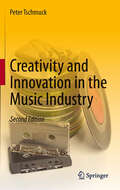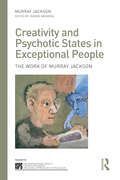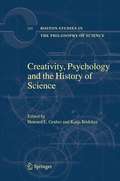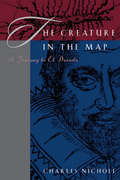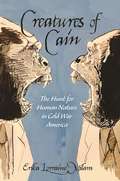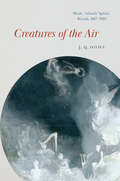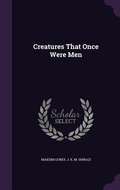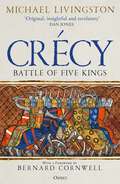- Table View
- List View
Creativity and Innovation in the Music Industry
by Peter TschmuckWhy did jazz become a dominant popular music genre in the 1920s and rock 'n' roll in the 1950s? Why did heavy metal, punk rock and hiphop find their way from sub-cultures to the established music industry? What are the effects of new communication technologies and the Internet on the creation of music in the early 21st century? These and other questions are answered by Peter Tschmuck through an integrated model of creativity and innovation that is based on an international history of music industry since Thomas A. Edison invented the phonograph in 1877. Thus, the history of the music industry is described in full detail. By discussing the historic process of music production, distribution and reception the author highlights several revolutions in the music industry that were caused by the inference of aesthetic, technological, legal, economic, social and political processes of change. On the basis of an integrated model of creativity and innovation, an explanation is given on how the processes and structures of the present music industry will be altered by the ongoing digital revolution, which totally changed the value-added network of the production, dissemination and use of music. For the second edition, the author has reworked chapter 9 in order to include all the developments which shaped the music industry in the first decade of the 21st century – from Napster to cloud-based music services and even beyond.
Creativity and Psychotic States in Exceptional People: The work of Murray Jackson (The International Society for Psychological and Social Approaches to Psychosis Book Series)
by Murray JacksonCreativity and Psychotic States in Exceptional People tells the story of the lives of four exceptionally gifted individuals: Vincent van Gogh, Vaslav Nijinsky, José Saramago and John Nash. Previously unpublished chapters by Murray Jackson are set in a contextual framework by Jeanne Magagna, revealing the wellspring of creativity in the subjects’ emotional experiences and delving into the nature of psychotic states which influence and impede the creative process. Jackson and Magagna aim to illustrate how psychoanalytic thinking can be relevant to people suffering from psychotic states of mind and provide understanding of the personalities of four exceptionally talented creative individuals. Present in the text are themes of loving and losing, mourning and manic states, creating as a process of repairing a sense of internal damage and the use of creativity to understand or run away from oneself. The book concludes with a glossary of useful psychoanalytic concepts. Creativity and Psychotic States in Exceptional People will be fascinating reading for psychiatrists, psychotherapists and psychoanalysts, other psychoanalytically informed professionals, students and anyone interested in the relationship between creativity and psychosis.
Creativity and Psychotic States in Exceptional People: The work of Murray Jackson (The International Society for Psychological and Social Approaches to Psychosis Book Series)
by Murray JacksonCreativity and Psychotic States in Exceptional People tells the story of the lives of four exceptionally gifted individuals: Vincent van Gogh, Vaslav Nijinsky, José Saramago and John Nash. Previously unpublished chapters by Murray Jackson are set in a contextual framework by Jeanne Magagna, revealing the wellspring of creativity in the subjects’ emotional experiences and delving into the nature of psychotic states which influence and impede the creative process. Jackson and Magagna aim to illustrate how psychoanalytic thinking can be relevant to people suffering from psychotic states of mind and provide understanding of the personalities of four exceptionally talented creative individuals. Present in the text are themes of loving and losing, mourning and manic states, creating as a process of repairing a sense of internal damage and the use of creativity to understand or run away from oneself. The book concludes with a glossary of useful psychoanalytic concepts. Creativity and Psychotic States in Exceptional People will be fascinating reading for psychiatrists, psychotherapists and psychoanalysts, other psychoanalytically informed professionals, students and anyone interested in the relationship between creativity and psychosis.
The Creativity Code: Art and Innovation in the Age of AI
by Marcus Du Sautoy“A brilliant travel guide to the coming world of AI.” —Jeanette Winterson What does it mean to be creative? Can creativity be trained? Is it uniquely human, or could AI be considered creative? Mathematical genius and exuberant polymath Marcus du Sautoy plunges us into the world of artificial intelligence and algorithmic learning in this essential guide to the future of creativity. He considers the role of pattern and imitation in the creative process and sets out to investigate the programs and programmers—from Deep Mind and the Flow Machine to Botnik and WHIM—who are seeking to rival or surpass human innovation in gaming, music, art, and language. A thrilling tour of the landscape of invention, The Creativity Code explores the new face of creativity and the mysteries of the human code. “As machines outsmart us in ever more domains, we can at least comfort ourselves that one area will remain sacrosanct and uncomputable: human creativity. Or can we?…In his fascinating exploration of the nature of creativity, Marcus du Sautoy questions many of those assumptions.” —Financial Times “Fascinating…If all the experiences, hopes, dreams, visions, lusts, loves, and hatreds that shape the human imagination amount to nothing more than a ‘code,’ then sooner or later a machine will crack it. Indeed, du Sautoy assembles an eclectic array of evidence to show how that’s happening even now.” —The Times
The Creativity Complex: Art, Tech, and the Seduction of an Idea
by Shannon Steen“Creativity” is a word that excites and dazzles us. It promises brilliance and achievement, a shield against conformity, a channel for innovation across the arts, sciences, technology, and education, and a mechanism for economic revival and personal success. But it has not always evoked these ideas. The Creativity Complex traces the history of how creativity has come to mean the things it now does, and explores the ethical implications of how we use this term today for both the arts and for the social world more broadly. Richly researched, the book explores how creativity has been invoked in arenas as varied as Enlightenment debates over the nature of cognition, Victorian-era intelligence research, the Cold War technology race, contemporary K-12 education, and even modern electoral politics. Ultimately, The Creativity Complex asks how our ideas about creativity are bound up with those of self-fulfillment, responsibility, and the individual, and how these might seduce us into joining a worldview and even a set of social imperatives that we might otherwise find troubling.
Creativity, Problem Solving, and Aesthetics in Engineering: Today's Engineers Turning Dreams into Reality
by David BlockleyThis book illuminates what engineering is and how it relates to other disciplines such as art, architecture, law, economics, science, technology, and even religion. The author explains, from an intrinsic as well as descriptive perspective, why engineering is essential for our collective well-being, and how, like medicine, it is undertaken by people, and for people, to improve the human condition. He brings out the 'magic' of engineering practice as well as addressing the darker aspects such as warfare and the misuse of the internet. A too commonly held view assumes that the practice of engineers is a cold, purely quantitative and wholly technical enterprise of applying know science, and devoid of creativity or aestheticism. In 2013 the United States National Academy of Engineering launched a campaign called “Changing the Conversation, Messages for Improving Public Understanding of Engineering” with four messages to impart about engineers: that they make a world of difference; are creative problem solvers; that they help shape the future, and are essential to health, happiness, and safety. In this volume, Professor Blockley incorporate these messages into an engaging exposition of engineering accomplishment in all of its evolving diversity, from the technician to the academic research engineer, illustrating the continuum of thinking and purpose from the fixer of the gas boiler to the designers of the A380 and the iPhone.
Creativity, Psychology and the History of Science (Boston Studies in the Philosophy and History of Science #245)
by Katja Bödeker H. E. GruberCreativity, Psychology, and the History of Science offers for the first time a comprehensive overview of the oeuvre of Howard E. Gruber, who is noted for his contributions both to the psychology of creativity and to the history of science. The present book includes papers from a wide range of topics. In the contributions to creativity research, Gruber proposes his key ideas for studying creative work. Gruber focuses on how the thinking, motivation and affect of extraordinarily creative individuals evolve and how they interact over long periods of time. Gruber’s approach bridges many disciplines and subdisciplines in psychology and beyond, several of which are represented in the present volume: cognitive psychology, developmental psychology, history of science, aesthetics, and politics. The volume thus presents a unique and comprehensive contribution to our understanding of the creative process. Many of Gruber's papers have not previously been easily accessible; they are presented here in thoroughly revised form.
Creators, Conquerors, and Citizens: A History of Ancient Greece
by Robin Waterfield"We Greeks are one in blood and one in language; we have temples to the gods and religious rites in common, and a common way of life." So the fifth-century historian Herodotus has some Athenians declare, in explanation of why they would never betray their fellow Greeks to the enemy, the "barbarian" Persians. And he might have added further common features, such as clothing, foodways, and political institutions. But if the Greeks knew that they were kin, why did many of them side with the Persians against fellow Greeks, and why, more generally, is ancient Greek history so often the history of internecine wars and other forms of competition with one another? This is the question acclaimed historian Robin Waterfield sets out to explore in this magisterial history of ancient Greece. With more information, more engagingly presented, than any similar work, this is the best single-volume account of ancient Greece in more than a generation. Waterfield gives a comprehensive narrative of seven hundred years of history, from the emergence of the Greeks around 750 BCE to the Roman conquest of the last of the Greco-Macedonian kingdoms in 30 BCE. Equal weight is given to all phases of Greek history -- the Archaic, Classical, and Hellenistic periods. But history is not just facts; it is also a matter of how we interpret the evidence. Without compromising the readability of the book, Waterfield incorporates the most recent scholarship by classical historians and archaeologists and asks his readers to think critically about Greek history. A brilliant, up-to-date account of ancient Greece, suitable for history buffs and university students alike, Creators, Conquerors, and Citizens presents a compelling and comprehensive story of this remarkable civilization's disunity, underlying cultural solidarity, and eventual political unification.
Creators, Conquerors, and Citizens: A History of Ancient Greece
by Robin Waterfield"We Greeks are one in blood and one in language; we have temples to the gods and religious rites in common, and a common way of life." So the fifth-century historian Herodotus has some Athenians declare, in explanation of why they would never betray their fellow Greeks to the enemy, the "barbarian" Persians. And he might have added further common features, such as clothing, foodways, and political institutions. But if the Greeks knew that they were kin, why did many of them side with the Persians against fellow Greeks, and why, more generally, is ancient Greek history so often the history of internecine wars and other forms of competition with one another? This is the question acclaimed historian Robin Waterfield sets out to explore in this magisterial history of ancient Greece. With more information, more engagingly presented, than any similar work, this is the best single-volume account of ancient Greece in more than a generation. Waterfield gives a comprehensive narrative of seven hundred years of history, from the emergence of the Greeks around 750 BCE to the Roman conquest of the last of the Greco-Macedonian kingdoms in 30 BCE. Equal weight is given to all phases of Greek history -- the Archaic, Classical, and Hellenistic periods. But history is not just facts; it is also a matter of how we interpret the evidence. Without compromising the readability of the book, Waterfield incorporates the most recent scholarship by classical historians and archaeologists and asks his readers to think critically about Greek history. A brilliant, up-to-date account of ancient Greece, suitable for history buffs and university students alike, Creators, Conquerors, and Citizens presents a compelling and comprehensive story of this remarkable civilization's disunity, underlying cultural solidarity, and eventual political unification.
Creators of Mathematical and Computational Sciences
by Ravi P Agarwal Syamal K SenThe book records the essential discoveries of mathematical and computational scientists in chronological order, following the birth of ideas on the basis of prior ideas ad infinitum. The authors document the winding path of mathematical scholarship throughout history, and most importantly, the thought process of each individual that resulted in the mastery of their subject. The book implicitly addresses the nature and character of every scientist as one tries to understand their visible actions in both adverse and congenial environments. The authors hope that this will enable the reader to understand their mode of thinking, and perhaps even to emulate their virtues in life.
Creature Comforts: Book Two (Patterson Family Saga)
by Jessica StirlingThe second novel in Stirling's historical saga brings to light yet more dark secrets, amorous entanglements and murder...Elspeth and Anna Patterson of Balnesmoor have both married well: Elspeth to a wealthy wool merchant, Anna to the son of a respected factor. But they are far from happy. The two married sisters, leading oddly parallel lives, find themselves entangled in a web of infidelity, scandal, and heartache in the midst of Wellington's Peninsular War on the continent.The story continues in Hearts of Gold.
The Creature in the Map: A Journey to El Dorado
by Charles Nicholl"This brilliantly written reconstruction of Sir Walter Raleigh's 1595 South American journey combines painstaking scholarship, vivid travelogue, and an intuitive sensitivity for the many meanings of the El Dorado myth. . . . Nicholl brings this six-week expedition to life. . . . A rare treat for both intellect and imagination."—Kirkus Reviews "Walter Raleigh . . . was one of those Elizabethan all-rounders who still seem staggeringly larger than life. . . . Mr. Nicholl's cogent reconstruction of the journey uses Raleigh's own account, 'The Discoverie of Guiana'—part truth, part advertising, part rhapsody—and much well-found ancillary material."—Anthony Bailey, New York Times "Like The Reckoning, his brilliant account of the murder of Christopher Marlowe, Nicholl's new book might be called an exercise in historical conjuring. The Creature in the Map is an effort not only to analyse but also to call into presence the lived experience of the voyage Raleigh undertook in 1595 to the Orinoco Delta in what is now Venezuela."—Stephen Greenblatt, Times Literary Supplement "Charles Nicholl belongs to an elite company, that of historians who know how to make research into arcane matters and distant times as engrossing as In Cold Blood or All the President's Men."—Michael Dirda, Washington Post
Creatures Born of Mud and Slime: The Wonder and Complexity of Spontaneous Generation (Singleton Center Books in Premodern Europe)
by Daryn LehouxWe accept that, at some point in the history of our universe, living creatures emerged from nonliving matter. Yet from the time of Aristotle until the late nineteenth century, many people believed in spontaneous generation, that living creatures sprang into existence from rotting material. As Daryn Lehoux explains in this fascinating book, spontaneous generation was perhaps the last stand of the ancient scientific worldview. In Creatures Born of Mud and Slime, Lehoux shows that;¢;‚¬;€?far from being a superstitious, gullible, or simplistic belief;¢;‚¬;€?spontaneous generation was a sophisticated and painstakingly grounded fact that stood up to the best scientific testing. Starting with the ancient Greeks;€™ careful and detailed investigations into how animals are generated straight through to the early modern period, Lehoux brings to life the intellectual contexts, rivalries, observational evidence, and complex and fascinating theories that were used to understand and explain the phenomena.The book highlights both the weirdness and the wonder that lie at the heart of investigations into nature. Lehoux concludes with a new look at a set of conflicting experiments that demonstrate that even the best scientific evidence can end up muddying what we take to be the truth about the world. Creatures Born of Mud and Slime is a compelling look at how we understand conceptions of scientific change, truth, and progress.
Creatures Born of Mud and Slime: The Wonder and Complexity of Spontaneous Generation (Singleton Center Books in Premodern Europe)
by Daryn LehouxWe accept that, at some point in the history of our universe, living creatures emerged from nonliving matter. Yet from the time of Aristotle until the late nineteenth century, many people believed in spontaneous generation, that living creatures sprang into existence from rotting material. As Daryn Lehoux explains in this fascinating book, spontaneous generation was perhaps the last stand of the ancient scientific worldview. In Creatures Born of Mud and Slime, Lehoux shows that;¢;‚¬;€?far from being a superstitious, gullible, or simplistic belief;¢;‚¬;€?spontaneous generation was a sophisticated and painstakingly grounded fact that stood up to the best scientific testing. Starting with the ancient Greeks;€™ careful and detailed investigations into how animals are generated straight through to the early modern period, Lehoux brings to life the intellectual contexts, rivalries, observational evidence, and complex and fascinating theories that were used to understand and explain the phenomena.The book highlights both the weirdness and the wonder that lie at the heart of investigations into nature. Lehoux concludes with a new look at a set of conflicting experiments that demonstrate that even the best scientific evidence can end up muddying what we take to be the truth about the world. Creatures Born of Mud and Slime is a compelling look at how we understand conceptions of scientific change, truth, and progress.
Creatures of Attention: Aesthetics and the Subject before Kant (Signale: Modern German Letters, Cultures, and Thought)
by Johannes WankhammerCreatures of Attention excavates the early modern prehistory of our late modern crises of attention. At the threshold of modernity, philosophers, scientists, and poets across Europe began to see attention as the key to autonomous agency and knowledge. Recovering the philosophical and literary works from eighteenth-century Germany in which "attention," "subject," and "aesthetics" developed their modern meanings, Johannes Wankhammer examines control over attention as the cultural technique underpinning the ideal of individual autonomy. Aesthetics, founded by Alexander Baumgarten as a science of sense perception, challenged this ideal by reframing art as a catalyst for alternative modes of selfhood and attention. While previous scholarship on the history of attention emphasized the erosion of subjectivity by industrial or technological modernization, Wankhammer asks how attention came to define subjectivity in the first place. When periodically recurring crises of attention threaten the coherence of the subject, the subject comes undone at the very seams that first sutured it together. Creatures of Attention offers the first systematic study of a foundational discourse on attention from 1650 to 1780. Presenting pre-Kantian aesthetics as a critique of the Enlightenment paradigm of strained attention, the book offers a fresh perspective on poetics and aesthetics in eighteenth-century Germany.
Creatures of Cain: The Hunt for Human Nature in Cold War America
by Erika Lorraine MilamAfter World War II, the question of how to define a universal human nature took on new urgency. Creatures of Cain charts the rise and precipitous fall in Cold War America of a theory that attributed man’s evolutionary success to his unique capacity for murder.Drawing on a wealth of archival materials and in-depth interviews, Erika Lorraine Milam reveals how the scientists who advanced this “killer ape” theory capitalized on an expanding postwar market in intellectual paperbacks and widespread faith in the power of science to solve humanity’s problems, even to answer the most fundamental questions of human identity. The killer ape theory spread quickly from colloquial science publications to late-night television, classrooms, political debates, and Hollywood films. Behind the scenes, however, scientists were sharply divided, their disagreements centering squarely on questions of race and gender. Then, in the 1970s, the theory unraveled altogether when primatologists discovered that chimpanzees also kill members of their own species. While the discovery brought an end to definitions of human exceptionalism delineated by violence, Milam shows how some evolutionists began to argue for a shared chimpanzee-human history of aggression even as other scientists discredited such theories as sloppy popularizations.A wide-ranging account of a compelling episode in American science, Creatures of Cain argues that the legacy of the killer ape persists today in the conviction that science can resolve the essential dilemmas of human nature.
Creatures of Cain: The Hunt for Human Nature in Cold War America
by Erika Lorraine MilamAfter World War II, the question of how to define a universal human nature took on new urgency. Creatures of Cain charts the rise and precipitous fall in Cold War America of a theory that attributed man’s evolutionary success to his unique capacity for murder.Drawing on a wealth of archival materials and in-depth interviews, Erika Lorraine Milam reveals how the scientists who advanced this “killer ape” theory capitalized on an expanding postwar market in intellectual paperbacks and widespread faith in the power of science to solve humanity’s problems, even to answer the most fundamental questions of human identity. The killer ape theory spread quickly from colloquial science publications to late-night television, classrooms, political debates, and Hollywood films. Behind the scenes, however, scientists were sharply divided, their disagreements centering squarely on questions of race and gender. Then, in the 1970s, the theory unraveled altogether when primatologists discovered that chimpanzees also kill members of their own species. While the discovery brought an end to definitions of human exceptionalism delineated by violence, Milam shows how some evolutionists began to argue for a shared chimpanzee-human history of aggression even as other scientists discredited such theories as sloppy popularizations.A wide-ranging account of a compelling episode in American science, Creatures of Cain argues that the legacy of the killer ape persists today in the conviction that science can resolve the essential dilemmas of human nature.
Creatures of Empire: How Domestic Animals Transformed Early America
by Virginia DeJohn AndersonWhen we think of the key figures of early American history, we think of explorers, or pilgrims, or Native Americans--not cattle, or goats, or swine. But as Virginia DeJohn Anderson reveals in this brilliantly original account of colonists in New England and the Chesapeake region, livestock played a vitally important role in the settling of the New World. Livestock, Anderson writes, were a central factor in the cultural clash between colonists and Indians as well as a driving force in the expansion west. By bringing livestock across the Atlantic, colonists believed that they provided the means to realize America's potential. It was thought that if the Native Americans learned to keep livestock as well, they would be that much closer to assimilating the colonists' culture, especially their Christian faith. But colonists failed to anticipate the problems that would arise as Indians began encountering free-ranging livestock at almost every turn, often trespassing in their cornfields. Moreover, when growing populations and an expansive style of husbandry required far more space than they had expected, colonists could see no alternative but to appropriate Indian land. This created tensions that reached the boiling point with King Philip's War and Bacon's Rebellion. And it established a pattern that would repeat time and again over the next two centuries. A stunning account that presents our history in a truly new light, Creatures of Empire restores a vital element of our past, illuminating one of the great forces of colonization and the expansion westward.
Creatures of Empire: How Domestic Animals Transformed Early America
by Virginia DeJohn AndersonWhen we think of the key figures of early American history, we think of explorers, or pilgrims, or Native Americans--not cattle, or goats, or swine. But as Virginia DeJohn Anderson reveals in this brilliantly original account of colonists in New England and the Chesapeake region, livestock played a vitally important role in the settling of the New World. Livestock, Anderson writes, were a central factor in the cultural clash between colonists and Indians as well as a driving force in the expansion west. By bringing livestock across the Atlantic, colonists believed that they provided the means to realize America's potential. It was thought that if the Native Americans learned to keep livestock as well, they would be that much closer to assimilating the colonists' culture, especially their Christian faith. But colonists failed to anticipate the problems that would arise as Indians began encountering free-ranging livestock at almost every turn, often trespassing in their cornfields. Moreover, when growing populations and an expansive style of husbandry required far more space than they had expected, colonists could see no alternative but to appropriate Indian land. This created tensions that reached the boiling point with King Philip's War and Bacon's Rebellion. And it established a pattern that would repeat time and again over the next two centuries. A stunning account that presents our history in a truly new light, Creatures of Empire restores a vital element of our past, illuminating one of the great forces of colonization and the expansion westward.
Creatures of Jurisprudence: Bears and Bees as Juridical Species
by Edward MussawirTo what extent can an animal constitute a ‘juridical species’? This highly original book considers how animals have been integral to law and to legal thinking.Going beyond the traditional approaches to animal rights and the question of whether non-human animals may be considered legal ‘subjects,’ this book follows two types of animal – bears and bees – and asks what existence these species have maintained in juridical thought. Uncovering surprising roles that the animals play in the imagination of and solution to jurisprudential problems, the book offers a counter-argument to the view that juridical thought reduces one’s appreciation for the singularity and independence of their lives. It shows, rather, that the animals exert a remarkable influence on the creative dimensions of law, offering a liveliness to it that is worthy of close attention.Contributing to new directions at the intersection of jurisprudence and human–animal studies, this book will appeal to those with interests in either of these areas.
Creatures of Jurisprudence: Bears and Bees as Juridical Species
by Edward MussawirTo what extent can an animal constitute a ‘juridical species’? This highly original book considers how animals have been integral to law and to legal thinking.Going beyond the traditional approaches to animal rights and the question of whether non-human animals may be considered legal ‘subjects,’ this book follows two types of animal – bears and bees – and asks what existence these species have maintained in juridical thought. Uncovering surprising roles that the animals play in the imagination of and solution to jurisprudential problems, the book offers a counter-argument to the view that juridical thought reduces one’s appreciation for the singularity and independence of their lives. It shows, rather, that the animals exert a remarkable influence on the creative dimensions of law, offering a liveliness to it that is worthy of close attention.Contributing to new directions at the intersection of jurisprudence and human–animal studies, this book will appeal to those with interests in either of these areas.
Creatures of the Air: Music, Atlantic Spirits, Breath, 1817–1913 (New Material Histories of Music)
by J. Q. DaviesAn account of nineteenth-century music in Atlantic worlds told through the history of the art’s elemental medium, the air. Often experienced as universal and incorporeal, music seems an innocent art form. The air, the very medium by which music constitutes itself, shares with music a claim to invisibility. In Creatures of the Air, J. Q. Davies interrogates these claims, tracing the history of music’s elemental media system in nineteenth-century Atlantic worlds. He posits that air is a poetic domain, and music is an art of that domain. From West Central African ngombi harps to the European J. S. Bach revival, music expressed elemental truths in the nineteenth century. Creatures of the Air tells these truths through stories about suffocation and breathing, architecture and environmental design, climate strife, and racial turmoil. Contributing to elemental media studies, the energy humanities, and colonial histories, Davies shows how music, no longer just an innocent luxury, is implicated in the struggle for control over air as a precious natural resource. What emerges is a complex political ecology of the global nineteenth century and beyond.
Creatures of the Air: Music, Atlantic Spirits, Breath, 1817–1913 (New Material Histories of Music)
by J. Q. DaviesAn account of nineteenth-century music in Atlantic worlds told through the history of the art’s elemental medium, the air. Often experienced as universal and incorporeal, music seems an innocent art form. The air, the very medium by which music constitutes itself, shares with music a claim to invisibility. In Creatures of the Air, J. Q. Davies interrogates these claims, tracing the history of music’s elemental media system in nineteenth-century Atlantic worlds. He posits that air is a poetic domain, and music is an art of that domain. From West Central African ngombi harps to the European J. S. Bach revival, music expressed elemental truths in the nineteenth century. Creatures of the Air tells these truths through stories about suffocation and breathing, architecture and environmental design, climate strife, and racial turmoil. Contributing to elemental media studies, the energy humanities, and colonial histories, Davies shows how music, no longer just an innocent luxury, is implicated in the struggle for control over air as a precious natural resource. What emerges is a complex political ecology of the global nineteenth century and beyond.
Creatures That Once Were Men
by Maksim GorkyA collection of short stories by the popular and influential Russian author, a founder of the socialist realism literary method and arguably the greatest Russian literary figure of the 20th century. He wrote stories, plays, memoirs and novels which touched the imagination of the Russian people, and was the first Russian author to write sympathetically of such characters as tramps and thieves, emphasizing their daily struggles against overwhelming odds.
Crécy: Battle of Five Kings
by Michael Livingston'Like Crécy itself, this book is a triumph and the tale it tells gives an old story new life.'BERNARD CORNWELL, bestselling author of The Last Kingdom seriesA groundbreaking new study of the battle of Crécy, in which the outnumbered English under King Edward III won a decisive victory over the French and changed the course of the Hundred Years War. The battle of Crécy in 1346 is one of the most famous and widely studied military engagements in history. The repercussions of this battle were felt for hundreds of years, and the exploits of those fighting reached the status of legend. Yet cutting-edge research has shown that nearly everything that has been written about this dramatic event may be wrong.In this new study, Michael Livingston reveals how modern scholars have used archived manuscripts, satellite technologies and traditional fieldwork to help unlock what was arguably the battle's greatest secret: the location of the now quiet fields where so many thousands died. Crécy: Battle of Five Kings is a story of past and present. It is a new history of one of the most important battles of the Middle Ages: a compelling narrative account of the battle of Crécy that still adheres to the highest scholarly standards in its detail. It is also an account that incorporates the most cutting-edge revelations and the personal story of how those discoveries were made.
